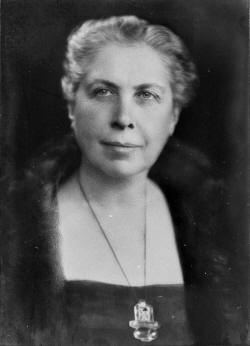

Partner Honor Bone, Marie Lawson
Queer Places:
(1910) 86 Porchester Terrace, London W
(1932) 21 North Gate, Prince Albert Rd, St John's Wood,
London NW8 7EL, UK
Four Winds, Old Guildford Rd, Frimley Green, Camberley GU16 6PG, UK
West Norwood Cemetery and Crematorium
West Norwood, London Borough of Lambeth, Greater London, England
 Christine Mary Murrell (18 October 1874 – 18 October 1933)[1] was
an English medical doctor. In 1924, she became the first female member of
the British Medical Association's Central Council. She lived with
Honor Bone and
Marie Lawson for over 30 years.
Christopher St. John had a dual
dedication, to Honor Bone and Marie Lawson, in her biography Christine Murrell
M.D. (1935). Written at the request of Honor Bone, Christine Murrell's lover,
the book acknowledge the fact that Murrell lived with two women, both of whom
had loving significance for her. By 1925 all three women were able to move
into a house which Murrell had herself designed, The Four Winds, Frimley
Green, near Aldershot. In 1930, the triple domestic partnership was extended
to London, where Murrell and Bone were already living together. After
Murrell's death, Bone was still living at Four Winds in 1941, but Marie
Lawson, although in regular and fond contact with her, was no longer living
with her.
Christine Mary Murrell (18 October 1874 – 18 October 1933)[1] was
an English medical doctor. In 1924, she became the first female member of
the British Medical Association's Central Council. She lived with
Honor Bone and
Marie Lawson for over 30 years.
Christopher St. John had a dual
dedication, to Honor Bone and Marie Lawson, in her biography Christine Murrell
M.D. (1935). Written at the request of Honor Bone, Christine Murrell's lover,
the book acknowledge the fact that Murrell lived with two women, both of whom
had loving significance for her. By 1925 all three women were able to move
into a house which Murrell had herself designed, The Four Winds, Frimley
Green, near Aldershot. In 1930, the triple domestic partnership was extended
to London, where Murrell and Bone were already living together. After
Murrell's death, Bone was still living at Four Winds in 1941, but Marie
Lawson, although in regular and fond contact with her, was no longer living
with her.
Dr Christine Murrell, about whom Christopher St. John wrote a biography, joined forces with her ‘beloved friend and colleague’ Dr Honor Bone early in her professional life and lived with her for over 30 years, the last of these spent in a ménage à trois with Marie Lawson, a printer, editor and tax resister. Murrell and Bone worked in general practice together in West London; Murrell, who also used the forename ‘Christopher’, ran one of the first infant welfare clinics, helped with the aftercare of imprisoned suffragettes and became the first woman elected to the Council of the British Medical Association in 1924 and to the General Medical Council in 1933.
Murrell was born in 1874 in Clapham, London. Her parents were Charles Murrell, a coal merchant, and Alice Elizabeth Rains.[1] She attended Clapham High School for Girls and the London School of Medicine for Women, receiving an MBBS in 1899.[2] She spent the beginning of her career in various positions in Northumberland and Liverpool before returning to London to work at the Royal Free Hospital,[1] where she was only the second woman to serve as a house physician.[3] In 1903, she established a private practice in Bayswater with her friend Elizabeth Honor Bone. Murrell received an MD in psychology and mental diseases from the University of London in 1905. From 1907, she led an infant welfare clinic run by the St Marylebone Health Society at Lisson Grove for 18 years.[1]
Murrell was also an activist for women's rights, and was involved in the women's suffrage movement before the First World War. During the war, she served in and became chair of the Women's Emergency Corps. She gave public lectures on women's health for 20 years at the London County Council, and in 1923 she published a series of lectures under the title Womanhood and Health. In 1925, she and Letitia Fairfield conducted a survey of girls' experiences of menstruation; the findings were published in The Lancet in 1930.[1] Murrell served on various committees of the British Medical Association, and in 1924 she became the first woman elected to its Central Council; she sat on the council for nine years, until her death.[2] She was the fifth president of the Medical Women's Federation, from 1926 to 1928. In September 1933, she was the first female representative elected to the General Medical Council, but she died on 18 October 1933 before taking her seat.[1][3]
My published books: